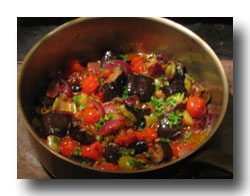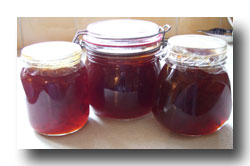|
|
|
 |
 |
|
|
Do you have a recipe that you want to share? Send it in to the Webmaster and we’ll add it to this page. Send in a photo, if you have one, of the finished product as well.
|
 |
|
Salad of roasted beetroot with fennel and marinated feta cheese
Well, it’s been some time in the making but here we are. This is a little creation from the last menu at the Queen’s Head and is a starter from Perry Frost, our up and coming apprentice. Sometimes people forget the little folk that work like Trojans to climb the career ladder. We will persevere with Perry and hopefully he will blossom into a chef who goes on to teach many more.
4 fresh raw beetroot peeled and cut into wedges
2 whole chilli cut into 6
5 cloves of garlic peeled and sliced
6 tbsp olive oil
2 heads fennel
1 pack feta cheese
2 tsp ground coriander
1 tbsp fennel seeds
Lettuce leaves and fresh garden herbs
- Place the beetroot, chilli, garlic and olive oil in a bowl and stir to cover the beetroot with oil. Place on a roasting tray lined with baking parchment. Roast for 10 minutes or until the beetroot is cooked.
- Take 2 heads of fresh fennel and cut in half. Remove the root and then slice into thin strips. Sweat gently without colour in a tbsp of olive oil. Season with salt and ground pepper and leave to cool.
- Cut one pack of feta cheese into ½ inch cubes and place in a bowl. Heat 150ml olive oil in a pan with 2 tsp ground coriander and 1tsp fennel seeds. Sweat gently and cook out the powder without burning. Allow to cool. Once the oil has cooled, pour over the feta cheese and spoon gently to coat the cheese.
- Once you have all of your ingredients, place the feta and fennel in a bowl with some picked lettuce leaves mixed with fresh garden herbs. If you can, mix rocket and baby spinach with chives and fresh coriander to give you a taste sensation. Warm the beetroot through in the oven and place on a plate with the leaves and feta on top. Drizzle with a little olive oil and serve as a light summer lunch or as a starter to enjoy early evening. You could even make the salad and serve in a large bowl with a barbeque - that’s if we get any good weather!!
The next dish to come to these pages will be from Steven Cannell our enthusiastic head chef. His new menu is up and running and is very tasty. See my waist line for details!!!!
Alan Randall
Queen’s Head
|
 |
|
STEAMED STEAK AND KIDNEY SUET PUDDING
Dan Bryant, the head chef at the Queen’s Head Inn, Brandeston, prepared this dish for the second “Feast For a Tenner” evening in January. He served it with creamy mashed potatoes, mashed root vegetables and an onion gravy.
1 Large onion
2 Cloves of garlic
200g Button mushrooms
2 Large sprigs of thyme
1kg Steak and kidney mix from your butcher (not that supermarket rubbish)
Adnams broadside (enough to cover the mix)
250g Suet
125g Self raising flour
Flour for rolling meat in
Butter for greasing the moulds
- Finely chop the onions and garlic and sweat with a tiny splash of oil in a large pan until soft
- Add the mushrooms and thyme and cook for a couple of minutes
- Roll the steak and kidney mix in flour and seal the meat in a separate pan with a splash of oil
- When sealed, add to the pan with the onions, garlic, thyme and mushrooms
- Cover the mix with Adnams Broadside and cook for 3-4 hours on a low heat.
- Mix the suet and flour together with a little water until it makes a firm but sticky dough
- Grease 6 small pudding basins with butter and dust with flour
- Cut the pastry into six even pieces. Keep 6 small pieces back for lids
- Roll out the pastry on a floured surface and then gently line the moulds leaving a little overhanging
- Fill the moulds with the steak and kidney mix, then cover with the pastry that you left to one side for the lid.
- Fold over the overhanging pastry and make a firm seal with a little water
- Cover with foil and steam for 3-4 hours. When cooked, turn out on a plate and serve with roasted root vegetables and mashed potato. Lovely.
Hope you all enjoy this dish.
Dan Bryant
Head Chef
The Queens Head, Brandeston.
|
 |
|
Sicilian aubergine stew (caponata)
This is a sweet and sour dish, simple and delicious, with probably as many variations as there are villages in Sicily, so it’s not one of those Delia Smith dishes which insist on an exact and slavish replication of the recipe. It can be eaten cold with crusty bread as an antipasto or hot as a stew or as an accompaniment to meat, especially chicken. The amounts below make about enough for two as a main course. It’s even better the day after, but it’s unlikely that you’ll have any left.
Aubergine
Red onion, though the white sort will do
Celery 2 sticks
Capers 1 tsp
Garlic 1 clove, peeled and thinly sliced
Olives About a dozen, preferably green but black will do
Tomatoes Two large, chopped, or a handful of cherry tomatoes kept whole
Wine vinegar 1 tsp
Sugar A good pinch
Tomato paste (optional)
Oregano
Parsley, chopped
Olive oil
Salt & pepper
- Chop the aubergine into biggish chunks, say not less than about an inch and a half, and salt it. Leave for an hour.
- Soak the capers in water
- Chop the celery and blanch it for a few minutes in boiling water, then drain
- Slice the onion thinly
- Rinse the aubergine and pat it dry, then brown the pieces quickly in a sauté pan, sprinkling with oregano as you do so. You will probably have to do it in two batches so the pieces aren’t too crowded
- Put all the aubergine back in the pan, turn down the heat a little and add the onion, garlic, celery and parsley. Cook for a couple of minutes
- Add the capers and olives, and sprinkle in the vinegar
- Add the tomatoes and tomato paste if desired, sugar, salt and pepper, and cover the pan. Simmer for 15 minutes. Check from time to time for consistency – ideally it would remain quite chunky - taking off the lid if you think it’s a little too moist.
- You could finish the dish with a last sprinkling of parsley or a final glug of olive oil, to give added rich taste and sheen.
 |
|
 |
|
Dick Moore’s Seville Orange Marmalade
Dick Moore lives in Earl Soham and has been making marmalade to this recipe for decades - he’s actually 96 in 2007 and plans to make a few batches again this year when the oranges are in the shops. 
Seville Oranges 4 lbs (2 Kg)
Granulated Sugar 8 lbs (4 Kg)
Water 6 pints (3.5 Litres)
- Wash the fruit and remove any stalks.
- Simmer the whole fruit gently in 4 pints (2 Litres) of water in a saucepan with a tight-fitting lid for at least two hours until tender. Do this in the evening so that it can cool overnight.
- Pour the liquor into a preserving pan.
- Cut the oranges in half and scrape the pulp, pips and pith to an open saucepan with the remaining water. (Cut the fruit on a clean tray to catch the juice). Boil for at least an hour.
- While this is boiling, cut the peel to the preferred size and add to the liquid in the preserving pan.
- Put the sugar into a bowl and heat it in the oven at 100C.
- Strain the liquor from the pulp, pips and pith into the preserving pan. Squeeze the residual pulp through a sieve, a little at a time, into the preserving pan. All you should have left are the pips.
- Carefully add the heated sugar to the preserving pan and stir until dissolved.
- Boil until the setting point is reached. This can be around two hours. Test for the setting point by putting some of the marmalade onto a cold plate, allowing it to cool and pushing it to see if it crinkles.
- While the marmalade is boiling, clean the jars and place them in the oven set to 100C; if you use 1lb jars, you will need at least 12.
- Continuing to boil the marmalade will cause it to darken but be careful that you don’t cause it to set too much.
- Take off the heat and allow to cool slightly, stirring all the time so that the scum is absorbed into the liquid. This also helps to prevent the peel from settling.
- Ladle carefully into the heated jars, seal and allow to cool.
Dick recommends that the marmalade be kept for at least six months to improve the flavour.
If you plan to make a second batch later in the year, clean the Seville oranges and freeze them and cook from frozen as above.

|
|


